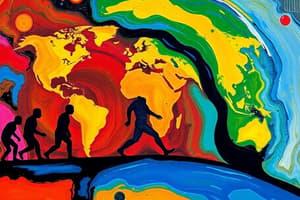Podcast
Questions and Answers
What does this unit deal with?
What does this unit deal with?
The origin and evolution of the earth, the interior of the earth, Wegener's continental drift theory and plate tectonics, earthquakes and volcanoes
What is the most popular argument regarding the origin of the universe?
What is the most popular argument regarding the origin of the universe?
The Big Bang Theory
According to the Big Bang Theory, the universe is contracting?
According to the Big Bang Theory, the universe is contracting?
False (B)
The Big Bang took place ______ billion years ago.
The Big Bang took place ______ billion years ago.
Which of the following is a measure of distance and not of time?
Which of the following is a measure of distance and not of time?
What is meant by the process of differentiation?
What is meant by the process of differentiation?
What was the nature of the Earth's surface initially?
What was the nature of the Earth's surface initially?
What were the gases that initially formed the Earth's atmosphere?
What were the gases that initially formed the Earth's atmosphere?
Which agency launched the Stardust project?
Which agency launched the Stardust project?
Why are scientists interested in collecting Stardust?
Why are scientists interested in collecting Stardust?
Where is Stardust being collected from?
Where is Stardust being collected from?
Flashcards
Accretion
Accretion
Process by which planets are formed from dust and gas.
Big Bang Theory
Big Bang Theory
Theory that describes the origin of the universe through a massive explosion.
Nebular Hypothesis
Nebular Hypothesis
Theory that planets formed from clouds of gas and dust around a young sun.
Singularity
Singularity
Signup and view all the flashcards
Galaxies
Galaxies
Signup and view all the flashcards
Light Year
Light Year
Signup and view all the flashcards
Planetary Formation
Planetary Formation
Signup and view all the flashcards
Evolution of Atmosphere
Evolution of Atmosphere
Signup and view all the flashcards
Degassing
Degassing
Signup and view all the flashcards
Photosynthesis
Photosynthesis
Signup and view all the flashcards
Oceans Formation
Oceans Formation
Signup and view all the flashcards
Life Origin
Life Origin
Signup and view all the flashcards
Primordial Atmosphere
Primordial Atmosphere
Signup and view all the flashcards
Thermal Evolution
Thermal Evolution
Signup and view all the flashcards
The Solar Nebula
The Solar Nebula
Signup and view all the flashcards
Earth Layers
Earth Layers
Signup and view all the flashcards
Rapid Expansion
Rapid Expansion
Signup and view all the flashcards
Current Atmosphere Composition
Current Atmosphere Composition
Signup and view all the flashcards
Forming Stars
Forming Stars
Signup and view all the flashcards
Geological Time Scale
Geological Time Scale
Signup and view all the flashcards
Surface Cooling
Surface Cooling
Signup and view all the flashcards
Planet Formation Stages
Planet Formation Stages
Signup and view all the flashcards
Solar Winds
Solar Winds
Signup and view all the flashcards
Heavy Materials
Heavy Materials
Signup and view all the flashcards
Gaseous Bodies
Gaseous Bodies
Signup and view all the flashcards
Cosmic Dust
Cosmic Dust
Signup and view all the flashcards
Planet Determinants
Planet Determinants
Signup and view all the flashcards
Evolution of Life
Evolution of Life
Signup and view all the flashcards
Mass Extinction
Mass Extinction
Signup and view all the flashcards
Study Notes
Unit II: The Earth
- This unit examines the origin and evolution of Earth, including its interior, Wegener's continental drift theory, plate tectonics, earthquakes, and volcanoes.
The Origin and Evolution of the Earth
- Early Theories: Early hypotheses about Earth's origin included the Nebular Hypothesis, proposed by Kant and revised by Laplace. This theory suggested that planets formed from a cloud of material associated with a young sun. Later modifications, by Otto Schmidt and Carl Weizsäcker, considered a solar nebula composed primarily of hydrogen and helium. Accretion was recognized as a significant process in planetary formation.
- Modern Theories (Big Bang Theory): The Big Bang Theory is the prevailing model for the origin of the universe. It describes the universe beginning from a very hot, dense state and expanding over time. This theory explains that galaxies are moving away from each other, supporting the idea of an expanding universe. Density differences in the early universe contributed to gravitational forces drawing matter together, forming the basis for galaxies.
- Star Formation: Galaxies are collections of stars. Galaxies form from the accumulation of hydrogen gas (nebula). Star formation occurs through the growth of gas clouds (nebula) into denser bodies. This process has been occurring for 5-6 billion years.
- Formation of Planets: The formation of planets involves a series of stages: Localized gas lumps within a nebula, gravitational force creating a core, a rotating disk of gas/dust forming around the core.
- Evolution of Earth's Layered Structure: Earth's early stage was a hot, barren, rocky object with a thin atmosphere (hydrogen and helium). Differentiation, the process of separation of materials based on density, resulted in the layered structure of the Earth (atmosphere, crust, mantle, core). The cooling process led to the formation of a solid outer surface (crust).
- Evolution of Atmosphere and Hydrosphere: The early atmosphere was different and contained gases like hydrogen, helium, carbon dioxide, methane, and little free oxygen. Loss of primordial atmosphere, outgassing contributing gases from the interior, formation of oceans over millions of years, and the process of photosynthesis (which began 3.8 billion years ago), all led to the formation of today's atmosphere rich in oxygen.
- Origin of Life: Life originated about 3.8 billion years ago. Early life existed in oceans. Photosynthesis released oxygen into the oceans, and later, the atmosphere.
Exercises: Multiple Choice Questions
- Multiple-choice questions are provided to assess understanding about factors like Earth's age (4.6 billion years), the formation of the atmosphere and hydrosphere, and the appearance of life (around 3.8 billion years ago).
Project Work: Stardust Project
- Information regarding the Stardust project, including the agency involved, the motivation behind collecting samples of stardust, and the origination point of the samples, is sought.
Studying That Suits You
Use AI to generate personalized quizzes and flashcards to suit your learning preferences.




